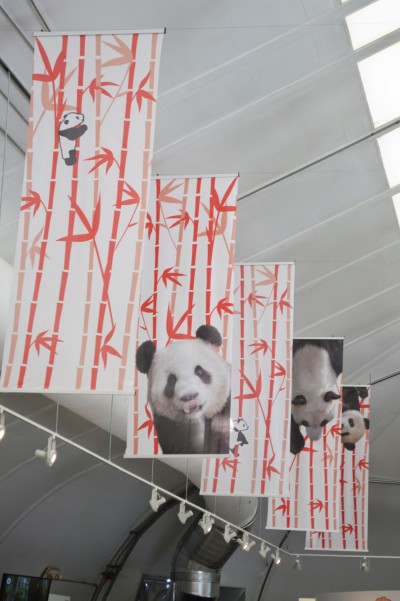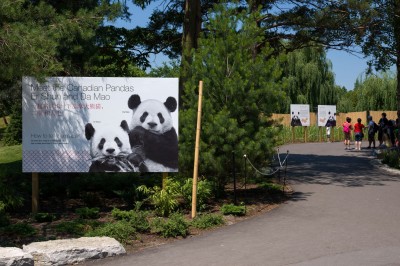Fabrication and installation
In January 2013, R+P had to find a fabricator to turn the sign designs into reality. The firm turned to Toronto-based Holman Exhibits, with which it had worked in the past.
“As we develop our designs, we work with exhibit specialists to ensure we have a good sense of what’s possible or not, in terms of substrates and graphic production techniques,” says Chow. “Once the project is at the fabrication stage, however, the exhibit fabricator may recommend other material choices that are better-suited to accomplishing our design goals.”
“After we visited the site, we changed some of the material specifications, as it wasn’t yet climate-controlled,” explains James Cummings, project manager for Holman. “We also added components to the designs, such as ‘kicks’ that protect the graphics from being bumped when the centre is being cleaned.”
Indeed, while Holman’s project bid was based on R+P’s original design package, there were numerous changes between the proposal and the installation (which Holman also handled directly).
“It’s hard to visualize everything until you mock it up with proofs and samples,” says Cummings. “As we built lighting panels, for instance, we could better determine the exactquantity needed for the space. We prototyped a lot of stuff for this project.”
In another example, many of the banners and signs needed to be installed within weighted frames to avoid being blown around by the facility’s large ceiling fans.
Indoor signs were constructed by mounting screenprinted vinyl onto expanded closed-cell polyvinyl chloride (PVC) boards, so graphics could be easily removed and changed when needed. Outdoor signs used medium-density overlay (MDO) plywood panelling, a more weather-resistant substrate.

Many of the banners needed to be installed within weighted frames to avoid being blown around by the facility’s large ceiling fans.
“We also added structural adhesives to hold curved panels in place,” Cummings says. “These are five-year displays, so they have to be resilient.”
This attention to detail helped reassure R+P the designs could be physically achieved within the newly renovated space.
“We like to have the people who produce graphics also install them,” says Smith.
As it turns out, one of Holman’s simplest tasks was not sign-related at all, where the design called for a full-scale pile of simulated panda poo.
“Pandas eat lots of bamboo, but they only get a few nutrients from it, so it passes through their system nearly unchanged,” Cummings explains. “This means you can just put bamboo in a blender and what comes out is very similar to panda poo. And that’s what we did. We started with a foam structure and covered it with chopped up bamboo. It was easy!”
The project’s main challenge, meanwhile, was the time frame for installation. Although Cummings and his team were brought on-board well ahead of time, the renovations for the interpretive centre were not finished until several months later.
“We had to wait until the building was complete,” he says, “then we had four weeks to get everything in there. And with updates, we received graphics in batches. On the Tuesday before the Friday the exhibit opened, we were still getting drawings for graphics we would have to install on Thursday. The work itself was all fairly straightforward, though.”
With files from the Toronto Zoo, R+P, Holman Exhibits and Global Exhibit Technology. For more information, visit www.torontozoo.com, www.reich-petch.com, www.holmanexhibits.com, www.global-exhibit-tech.com.
To view the full article, click here.






